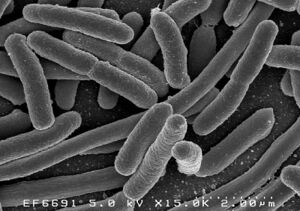Infections caused by Escherichia coli
Escherichia coli (EC) is a gram-negative bacterium that is a common commensal of the large and small intestine. E. coli causes:
- specific diarrheal diseases - mainly in infants, but also in adults
- non-specific intestinal (mostly exogenous infection) and extraintestinal diseases (mostly endogenous infection)
Type of E. coli
- according to body, capsular and flagellar antigen
- human E.coli can infect animals, but animal E.coli cannot infect humans
Occurrence[edit | edit source]
This bacterium is found in the vast majority of warm-blooded animals. It is part of the physiological microflora of the large intestine and the distal part of the ileum. A person is colonized almost immediately after birth, most often by alimentary route or transmission from an already inhabited individual. E. coli is unable to exist outside the host for a long time. Therefore, its finding (eg in drinking water) indicates contamination with feces.
Intestinal infection of E. coli[edit | edit source]
- infection in children are caused by E. coli , which get attached to the small intestine -for that, they need colonization factors (CFA) on the plasmid , which enables them to adhere to the mucosa
- they are divided according to the produced toxin:
- ETEC - enterotoxic strains (9-12 hours incubation)
- EIEC - enteroinvasive (10-18 hours incubation)
- EPEC - enteropatogenic (incubation 9–12 hours)
- EHEC - enterohemoragic (3-8 days)
- EAEC / EAggEC - enteroagregative
ETEC[edit | edit source]
- diarrhea in the tropics, there are different names for the disease (cholera-like disease, diarrhea of travelers , etc.)
- weaned child syndrome - in children with nutrient deficiency under poor hygienic conditions - after weaning from the breast the child has diarrhea
- caused by thermolabile or thermostable enterotoxin , production in the small intestine
- does not occur in the moderate (athmosphere)zone
EPEC[edit | edit source]
- they cause neonatal and infant diarrhea
- pathogenesis is not fully explained, there is around 14 serotypes
- severe diarrhea and vomiting - rapid dehydration
- source of infection - adult carriers
EIEC[edit | edit source]
- rather older children and adults, the course resembles a bacillary dysentery ("collisenteria")
- nausea and vomiting, fever , abdominal pain, stool quickly turns watery with mucus and blood
- tenesmus (urge on the stool)
- toxin allows them to penetrate intestinal epithelial cells (like shigels )
EHEC[edit | edit source]
Strains carrying the body antigen O157 are referred to as EHEC (enterohemorrhagic E. coli ) , sometimes also as STEC (shiga-like toxigenic), or VTEC (verotoxigenic).[1]
Penetration into the body is similar to other strains. The microbes then adhere to the brush border of the enterocytes . Verotoxin (shiga-like toxin) then enters into the bloodstream through the disrupted epithelium , leading to damaged erythrocytes and platelet aggregation and the subsequent formation of hyaline thrombus. Together with the released substances from damaged epithelium (especially endothelin), thrombi thus contribute to the failure of blood flow through the kidneys and the so-called hemolytic-uremic syndrome develops .
Disruption of the intestinal mucosa is associated with leakage of fluids and blood into the intestine. This leads to severe bloody diarrhea that mimics shigellosis .
Therapy[edit | edit source]
- lighter forms - rehydration, hungry diet;
- more severe forms - hospitalization, parenteral treatment of homeostasis ;
- ATBs are not commonly used, optionally aminoglycosides ;
- otherwise adsorption ( Smecta® ), charcoal and disinfection ( Endiaron® ).
Extraintestinal E. coli infections[edit | edit source]
- mostly unusual serotypes, often resistant to ATB
- mostly endogenous when immunity is weakened
- E. coli is one of the most common causes of urinary tract infections
- in young children - sepsis , meningitis , in the elderly - urinary tract and bile duct infections
Links[edit | edit source]
related articles
Reference HORACEK, Jiri, et al. Basics of medical microbiology. 1st edition. Karolinum, 2000. ISBN 80-246-0006-4 . Source BENEŠ, Jiří. Study materials [online]. [feeling. 2010]. < http://jirben.wz.cz >. References
- ↑ [1]HORÁČEK, Jiří, et al. Základy lékařské mikrobiologie. 1. vydání. Karolinum, 2000. ISBN 80-246-0006-4.

